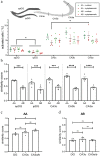Regional and interhemispheric differences of neuronal representations in dentate gyrus and CA3 inferred from expression of zif268
- PMID: 37891194
- PMCID: PMC10611715
- DOI: 10.1038/s41598-023-45304-y
Regional and interhemispheric differences of neuronal representations in dentate gyrus and CA3 inferred from expression of zif268
Abstract
The hippocampal formation is one of the best studied brain regions for spatial and mnemonic representations. These representations have been reported to differ in their properties for individual hippocampal subregions. One approach that allows the detection of neuronal representations is immediate early gene imaging, which relies on the visualization of genomic responses of activated neuronal populations, so called engrams. This method permits the within-animal comparison of neuronal representations across different subregions. In this work, we have used compartmental analysis of temporal activity by fluorescence in-situ hybridisation (catFISH) of the immediate early gene zif268/erg1 to compare neuronal representations between subdivisions of the dentate gyrus and CA3 upon exploration of different contexts. Our findings give an account of subregion-specific ensemble sizes. We confirm previous results regarding disambiguation abilities in dentate gyrus and CA3 but in addition report novel findings: Although ensemble sizes in the lower blade of the dentate gyrus are significantly smaller than in the upper blade both blades are responsive to environmental change. Beyond this, we show significant differences in the representation of familiar and novel environments along the longitudinal axis of dorsal CA3 and most interestingly between CA3 regions of both hemispheres.
© 2023. The Author(s).
Conflict of interest statement
The authors declare no competing interests.
Figures




Similar articles
-
Locus Coeruleus Phasic, But Not Tonic, Activation Initiates Global Remapping in a Familiar Environment.J Neurosci. 2019 Jan 16;39(3):445-455. doi: 10.1523/JNEUROSCI.1956-18.2018. Epub 2018 Nov 26. J Neurosci. 2019. PMID: 30478033 Free PMC article.
-
Preictal activity of subicular, CA1, and dentate gyrus principal neurons in the dorsal hippocampus before spontaneous seizures in a rat model of temporal lobe epilepsy.J Neurosci. 2014 Dec 10;34(50):16671-87. doi: 10.1523/JNEUROSCI.0584-14.2014. J Neurosci. 2014. PMID: 25505320 Free PMC article.
-
A dentate gyrus-CA3 inhibitory circuit promotes evolution of hippocampal-cortical ensembles during memory consolidation.Elife. 2022 Feb 22;11:e70586. doi: 10.7554/eLife.70586. Elife. 2022. PMID: 35191834 Free PMC article.
-
Disambiguating the similar: the dentate gyrus and pattern separation.Behav Brain Res. 2012 Jan 1;226(1):56-65. doi: 10.1016/j.bbr.2011.08.039. Epub 2011 Sep 2. Behav Brain Res. 2012. PMID: 21907247 Review.
-
An analysis of dentate gyrus function (an update).Behav Brain Res. 2018 Nov 15;354:84-91. doi: 10.1016/j.bbr.2017.07.033. Epub 2017 Jul 26. Behav Brain Res. 2018. PMID: 28756212 Review.
References
Publication types
MeSH terms
LinkOut - more resources
Full Text Sources
Miscellaneous

